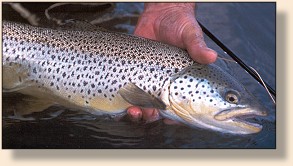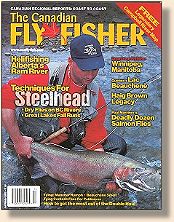The Downtown Fly Fisher
Calgary, Part 2

By Bruce Masterman
A virtual smorgasbord of fly fishing opportunities awaits along the
Eastern Slopes southwest of the city. Heading south on Secondary
940 - a road Alberta author Barry Mitchell dubbed Alberta's Trout
Highway in his recent book - you could fish a lifetime without
doing justice to Cataract Creek (brookies and rainbows), Willow
Creek (browns and brookies), Livingston River (cutthroats and bull
trout), Oldman River (rainbows, bulls and cutts), Racehorse Creek
(cutts), and Dutch Creek (cutts). In the southwestern corner of
the province, cutthroats and rainbows abound in the Crowsnest and
Castle rivers.
If fly fishing for northern pike is more your cup of tea, you
should head east and southeast of Calgary. Several irrigation
reserviors offer good pike fishing, including Chestermere Lake,
Travers Reservoir and Badger Lake. Glenmore Reservoir in Calgary
also offers good pike fishing. Even the Bow has a few. I once
caught a 24-inch pike in the Bow during an early-morning float
with legendary fly fishing writer John Gierach. He looked back
at the streamer hooked pike, disdainfully muttered "Nice pike" and
resumed fishing with a disgusted look on his face. For pike, you
should bring a good selection of large rabbit-fur streamers, such
as the Deceiver and Bunny Bug. Big Woolly Buggers also work. You
might want to check first with your doctor, to make sure your heart
can take it.
Main Attractions: The Bow
These rivers originate in the Rocky Mountains and flow eastward,
finally meeting more than 100 kilometers later at their confluence
near downtown Calgary, where Fort Calgary was established in 1875.
The part of the Bow that most interests fly fishers can be split
into three distinct stretches: the upper river that begins in Banff
National Park and tumbles eastward in a rollicking series of rapids,
pools, and long deep runs; the city section, a shallower reach blessed
with riffles, pocket water, and lively runs; and the most popular
reach, 55 kilometers of trout-rich classic fly-fishing water downstream
of Calgary to the Carseland Wier. Although there's some good fishing
for several kilometers downstream of Carseland, public access is limited
because much of it runs through a Native Reserve. Below that, the
Bow turns into a warmwater fishery, with northern pike, walleye and
burbot more common than trout.
Visiting anglers never cease to be impressed by Bow River rainbows,
often likening them to West Coast steelhead. They're powerful,
deep-bodied and extremely tenacious when hooked. Some fly fishers
call them silver bullets. The brown trout as just as tough, with
hooked jaws and thick, distinctive yellow bodies. Neither species
are pushovers, especially the big tackle-busters. When hooked,
larger browns and rainbows have a tendency to head straight for the
middle or far side of the river. Meanwhile, you're nervously
contemplating your fly line zipping off your reel and wondering how
much back you have on, and whether the connecting knot is good. It's
also difficult not to be impressed by the sheer numbers of trout. The
stretch between Calgary and Carseland boasts up to 2,000 rainbows and
browns per 1.6 kilometer.

The Bow is a big river, more than 75 meters across in places. As such,
many first-time visitors are inexperienced fly fishers find it
intimidating and frustrating. After all, with so much water to fish,
it can be difficult to know where to start. The best approach is
to view the river in smaller parts, rather than as one massive entity.
Look at it as you would a smaller river, creek or stream. Identify and
concentrate on potential trout-holding areas: the seam between fast
and slow-moving waters, undercut banks, natural pockets and indentations
along the banks, deep runs and shallow riffles, grass-lined banks,
sunken or overhanging trees, and other promising looking spots. Rather
than spending a lot of time trying to cast in mid-river, focus on
water closer to shore, where most of the trout hang out waiting for
insects and other good to drift by. Bow River dry-fly fanatics have
learned to be patient, looking before they cast, or wading to ensure
they don't spook a monster methodically sipping mayflies in 12 inches
of water tight against the bank. Random dry fly casting can be effective,
but a more selective approach is almost always better. You'll need to
be patient - and prepared to chance flies and techniques on a regular
basis until you hit the right one.
Continued Next Time!
Credits: This article is from the
Canadian Fly Fisher magazine. We appreciate use permission!
Our Man In Canada Archives
|

